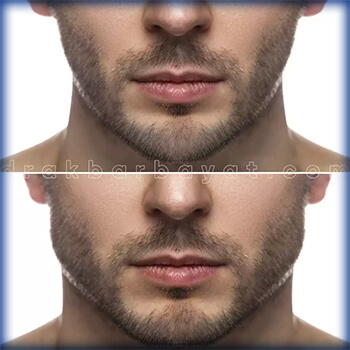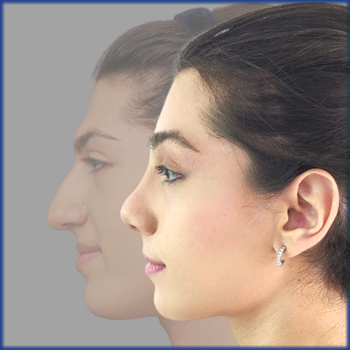
- As seen in this figure, the width of the nose is one-fifth the width of the face, which is equal to the space between the eyes. If you think your nose is too wide, you can use this method to find out if your nose is really wide or you are being picky.
- In full face view, the top line of the nose almost coincides with the line that connects the eyes and the bottom line (subnasal line) passes below the nostrils. Your nose covers nearly 43% of the length from the top line to your chin; that is, the rest of this length (57%) consists of the part that starts from the subnasal line and ends at the lower part of the chin). In individuals with small chin, the nose looks larger due to optical illusion. Therefore, it is important to note the size of the chin when visually appraising the nose.
Profile view
- In profile or side view, the angle formed by the nose and the upper lip is 90-95 degrees in men and 95-110 degrees in women (Figure 3). This is a good test to verify whether tour nose tip is downturned or not. Downturned nose tip gives your nose a longer look. So, this angle can be reduced in people who complain about having a long nose.
In profile view, the ideal angle between the nose and the forehead measures 115-135 degrees (Figure 4). Larger angles will make the nose look longer, while smaller angles make your nose appear shorter. Ideal outcomes can sometimes be reached just by modifying this angle without altering other parts.
In profile view, the proper angle formed by the nose and the face is 30 to 40 degrees. The ideal angle is 36 degrees (Figure 5). Your nose will look larger as this angle increases.
In profile view, the proper angle formed by the nose and the chin is 120-132 degrees. In this case, the upper lip is typically 4 mm away from the line connecting the nose to the chin, while the lower lip is placed at 2 mm from this line. Clearly, if over- or under-projected chin does not meet this criterion (Figure 6).
The first step in rhinoplasty is to visually appraise the nose and compare its dimensions to see whether it is in proportion to other parts of the face. The criteria described above are only a part of comprehensive criteria against which the nose should be appraised prior to surgery. You should analyze your photo and find the flaws in your nose before the surgery. Using this type of analysis and the applications developed for this purpose, you can better imagine what your nose will look life after the surgery and discuss your desirable outcomes during the pre-surgery consultation session.


